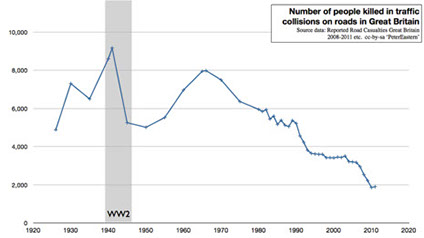LATEST NEWS FROM BRIDGE FLEET SOLUTIONS - OCTOBER 2015
As engines have become more more efficient and powerful over the years, vehicles have become faster. The first car on sale to the general public in 1894 was the Benz Velo with a top speed of only 12mph. By 1947 the Healey Type 2.4 had a top speed of 110.mph, and in 1987 the Ferrari F40 reached a blistering 202mph.
As car speeds increased, so did deaths from accidents. There is an undeniable link in the severity of injuries suffered from car accidents and the speed the vehicle was travelling at. But post 1965, even though cars continued to get faster, deaths from accidents started to decrease steadily year on year. This is due to combination of factors including changes in speed limits, advancements in medicine, and most importantly, improvements in vehicle safety features.
The graph below illustrates the number of people killed in traffic collisions on roads in Great Britain between 1920 and 2010

Crumple Zones – 1950s
These are areas of the car that are designed to crumple, absorbing the energy from the impact in the case of a crash. Modern cars have crumple zones in the front and rear of the vehicle, and mean that the areas of the vehicle where the driver and passengers sit are better protected. The introduction of crumple zones in the 1950s by Mercedes-Benz saw an immediate reduction in the number of crush injuries sustained to the legs of people involved in collisions.
Seatbelts - 1965
In 1965 it was made compulsory for all new cars to have mountings available for seatbelts. But it wasn’t until January 1983 that it was made compulsory to wear seatbelts, and even then it was only required in the front seats! But the benefits were huge, with a 29% reduction in fatal injuries in front seat passengers. In 1991 seat belts were finally made compulsory for all passengers, with modern 3-point seat belts reducing the chance of fatality in a car crash by around 50%.
Speed Limits - 1965
Although the 30mph speed limit commonly seen in built-up areas has been in effect since 1930, the 70mph limit that is present on duel carriageways and motorways wasn’t introduced until 1965. Before this there wasn’t much need for it, with many cars struggling to even reach 70mph. However after a number of motorway accidents, it became obvious that unrestricted roads were no longer suitable.
Airbags – 1980
The UK was late to the party when it comes to airbags, with America adopting their use in the 70s. The 1980 Mercedes Benz S class was the first car to be sold in the UK with Airbags. They work best in front on collisions where the driver would otherwise be thrown into the steering wheel or dashboard. In modern cars, airbags can be found in a variety of places other than the steering wheel, including the passenger’s dashboard and side doors.
At Bridge Fleet Solutions, we are experts in safety, and offer a range of solutions designed to improve fleet safety, while saving money. Be sure to get in touch to see how we can help you. For further information please contact us at info@bridgefleetsolutions.co.uk or give us a call on 0208 402 2350
Look how far we’ve come! A History of Vehicle Safety.
ARCHIVE NEWS
JANUARY 2016
DECEMBER 2015
NOVEMBER 2015
OCTOBER 2015
SEPTEMBER 2015
AUGUST 2015
JULY 2015
INDUSTRY NEWS
THE TRUTH ABOUT NO CLAIMS DISCOUNTS
The no-claims discount (NCD) has been a feature of car insurance for a long time, encouraging people to drive safely by rewarding them with lower premiums on renewal. But the benefits of hanging on to this feature of your policy may not be as worthwhile as you think.
Fleet registrations remain strong as demand for ultra-low emission vehicles rise
Fleet new car registrations in May were up 3% year-on-year, with 106,865 units registered to fleet and business during the month, equating to 53.7% of overall sales.The figures released today by the Society of Motor Manufacturers and Traders (SMMT) show that fleet and business registrations are now 10% up on where they were this time last year.
READ ARTICLE
Why bad driving will be eliminated by 2020 – and car insurance costs will plummet
Car insurance premiums could be just a fraction of current levels in five years’ time as driverless vehicles are expected to “eliminate bad driving” by 2020. Deaths and injuries caused by accidents are expected to virtually disappear and whiplash claims and car park disputes, which together account for 94pc of all insurance claims and cost insurers almost £3bn a year, could become a thing of the past as driverless technology will park our cars, brake automatically and swerve to avoid pedestrians and cyclists.
READ ARTICLE
What services are you interested in?
T: 0208 402 2350
INFO@BRIDGEFLEETSOLUTIONS.CO.UK
REQUEST A CALL BACK
BRIDGE FLEET SOLUTIONS: Stamford House, 57 Liddon Road , Bromley , Kent BR1 2SR t: 0208 402 2350